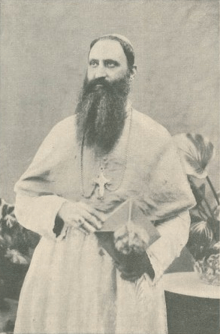Mateus de Oliveira Xavier

Dom Mateus de Oliveira Xavier (Vila de Rei, Vila de Rei, October 14, 1858 — Goa, May 19, 1929) was a Portuguese episcopate. He was Bishop of Cochin and Patriarch of the East Indies.
Biography
Son of Joaquim de Oliveira and Maria Joaquina Braz de Oliveira, he was educated by his priest-uncles, João and Sebastião de Oliveira Xavier e Aniceto de Oliveira. A student of Latin, he took his exam in the Liceu de Santarém. In 1874, he entered the Patriarchal Seminary of Santarém, to undertake ecclesiastical studies.
He was ordained a priest in Castelo Branco, in 1881, after which he headed to Coimbra. He studied theology at the University of Coimbra, where he was also chaplain at the convent of Santa Clara and the University. In 1888, he was appointed professor of ecclesiastical and preparatory studies, and spiritual director at the College of Overseas Missions in Sernache do Bonjardim, positions he held until 1893.
Private secretary, missionary, judge
In that year, the Patriarch of the East Indies, Dom António Sebastião Valente, was leave the kingdom to recuperate his failing health, and he invited Bishop Mateus to be his private secretary, a position he accepted, leaving for India on January 11, 1884. On March 5 both made their entry into Goa. Dom Mateus Xavier was named missionary for the Padroado in India by an order of 7 November 1893.
He landed in Cochin on 18 February, and was visiting one suffragan diocese at that time governed by Dom João Gomes Ferreira. In Goa, in addition the post of secretary of that patriarch, he was appointed judge of the Relação Metropolitana, judge of Seção Pontifícia, and finally rector of Rachol Seminary, a position of which he took office in June 1894.
At Rachol Seminary
He undertook much activity, reforming the seminar with new preparatory and theological studies and with government authorization and a papal brief, created the theology faculty there, thus making the Rachol seminary of the first and best of all India. On the death of the bishop of Cochin Dom João Gomes Ferreira, Dom Mateus Xavier was appointed to this post.
Transitions
Dom António Sebastião Valente and the minister for the Navy, Barros Gomes, promoted his nomination. The appointment was confirmed on October 11, 1897 by Pope Leo XIII. Since the Papal bulls were slow to reach India, the episcopal consecration could only be held January 30, 1898 in the Sé at Goa. He soon left for his diocese where he arrived on March 5, making his solemn entry and taking possession of his diocese.
Cathedral, caste
The first task of the new bishop was to raise the debris the new cathedral, the central nave of which had collapsed on a stormy night. Worse still, Christians from various churches had raised angry caste issues. He sought to sort out the issues of the Christians, opening the churches, and tried to raise the Cathedral. The building is majestic, mixing Manueline style with imitations of Indian buildings.
The work of the cathedral reconstruction began in mid-1898 and was open to the worship with the Te Deum for the coronation of Pope Pius X, on August 9, 1903, and solemnly consecrated on November 19, 1905, by Dom António Sebastião Valente, suffragan bishops and other neighbours, a total of 11 prelates. All the work was done by Indian artists. D. Mateus Xavier took care of the local education. The level and category of schools was raised. Smaller schools were elevated to high schools (liceus) with 15 and 20 teachers and a full course of preparations, allowing entry to Indian Universities.
By decree of December 31, 1908, after the death of Dom António Sebastião Valente, Bishop Mateus was elevated to being the Archbishop of Goa and Patriarch of the East Indies, a position he held until 1929 when he died. In 1928, with the addition of Daman diocese to the Archdiocese of Goa, he became Archbishop of Goa and Daman.
He was the principal co-consecrant of Don Angel María Pérez y Cecilia, O.C.D.
